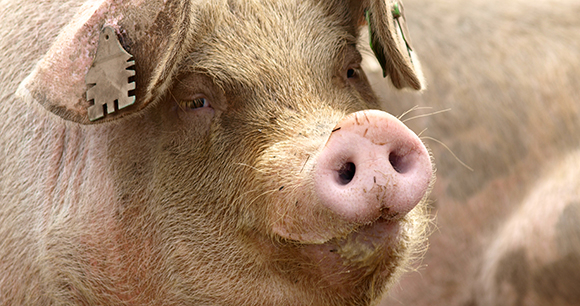
Groups call on public to oppose proposed USDA pork regulations that speed up slaughter lines, increasing chances for animal suffering
Washington, DC—The Animal Welfare Institute (AWI), the American Society for the Prevention of Cruelty to Animals (ASPCA), and Mercy For Animals (MFA) condemn the USDA’s plan, released last week, to allow pig slaughterhouses to kill pigs at “any speed deemed safe for food safety,” making animals vulnerable to rougher handling and to being butchered while still conscious.
The change would come through the USDA’s proposed adoption of the Hazard Analysis and Critical Control Points (HACCP) Inspection Models Project (or “HIMP”) for pig slaughter, which would allow facilities to run their lines at any speed if process controls are maintained. Pigs are already slaughtered at an astonishing rate of approximately 1,100 per hour. With this new rule, those speeds could reach up to 1,300 or even 1,500 pigs per hour—speeds virtually guaranteed to have torturous effects on the animals being rushed through the lines. The proposed rule, soon to be in a USDA public comment period, would also take some of the responsibility for ensuring food safety away from federal inspectors and place it in the hands of private slaughter plant employees.
Nearly 120 million pigs are slaughtered each year in the United States. While the food safety effects of the proposed change have been publicly debated for some time, the impact of HIMP on the pigs themselves has received far less attention. Our organizations oppose HIMP due to the negative impacts of higher slaughter speeds on animal welfare.
High-speed production jeopardizes the welfare of pigs at slaughter in three ways:
- Under the demands of the proposed rule, meat companies may pressure plant workers to move animals at a faster rate, from the time the pigs arrive at the slaughterhouse to the time they are slaughtered. Employing excessive force to drive pigs, including the use of electric prods and other abusive tools, causes pain and distress to the animals.
The following example was supplied by a USDA inspector at a HIMP plant in Minnesota: “I noticed that the animals on the east side were being moved faster than a normal walking speed. The hogs were exiting the circle pen at a run, and all were being prodded with a plastic paddle to maintain this speed.” In another incident at the same HIMP plant, a worker was observed hitting one pig in the face with a rattle paddle and then electrically prodding the same animal in the head. Another animal handler was seen “repeatedly slapping pigs in the crowd pen with a plastic paddle using excessive force.”
- The proposed rule could shorten the length of the stun used to render pigs insensible to pain before slaughter. Large pig slaughterhouses use either electric or gas (carbon dioxide) methods for stunning, and in both cases a shorter exposure time may result in pigs regaining consciousness prior to being butchered.
For example, a USDA inspector at one pork plant in Illinois noted that the company was forced to slow the CO2 stunning cycle “to allow more time for animals to be exposed to the gas” after every third or fourth animal shackled on the line showed signs of regaining consciousness.
- The proposed rule could prevent plant workers and government inspectors from being able to identify pigs who have not been adequately stunned and are still conscious on the processing line. It is imperative that conscious animals be recognized immediately to minimize the amount of animal suffering that occurs. The greater the number of pigs being slaughtered, and the faster the line is moving, the more difficult it is for plant personnel to stop the process and re-stun the animal. Failure to promptly intervene may result in a pig drowning in the scald tank or having limbs removed while still conscious.
Because faster line speeds raise the potential that pigs will be inhumanely handled or slaughtered, our organizations strongly urge the USDA to remove the unlimited line speed from the HIMP proposed rule. We encourage animal welfare advocates to speak out against this proposed rule, and let the USDA know that animal suffering in the pursuit of increased profit is not acceptable.
Amey Owen, (202) 446-2128, [email protected]
About the Animal Welfare Institute
The Animal Welfare Institute (www.awionline.org) is a nonprofit charitable organization founded in 1951 and dedicated to reducing animal suffering caused by people. AWI engages policymakers, scientists, industry, and the public to achieve better treatment of animals everywhere—in the laboratory, on the farm, in commerce, at home, and in the wild. For more information, visit www.awionline.org.
About the ASPCA
Founded in 1866, the ASPCA® (The American Society for the Prevention of Cruelty to Animals®) is the first animal welfare organization in North America and serves as the nation’s leading voice for animals. More than two million supporters strong, the ASPCA’s mission is to provide effective means for the prevention of cruelty to animals throughout the United States. As a 501(c)(3) not-for-profit corporation, the ASPCA is a national leader in the areas of anti-cruelty, community outreach and animal health services. For more information, please visit www.ASPCA.org, and be sure to follow the ASPCA on Facebook, Twitter, and Instagram.
About Mercy For Animals
Mercy For Animals (MFA) is a leading international animal protection charity dedicated to preventing cruelty to farmed animals and promoting compassionate food choices and policies. With operations in the United States, Canada, Brazil, Mexico, India, and Asia, MFA has conducted more than 60 undercover investigations of factory farms and slaughterhouses. Our corporate campaigns, which seek to end the worst forms of institutionalized animal abuse, have impacted animals in over 90 countries. To learn more, please visit www.mercyforanimals.org and follow us on Facebook, Twitter, and Instagram.